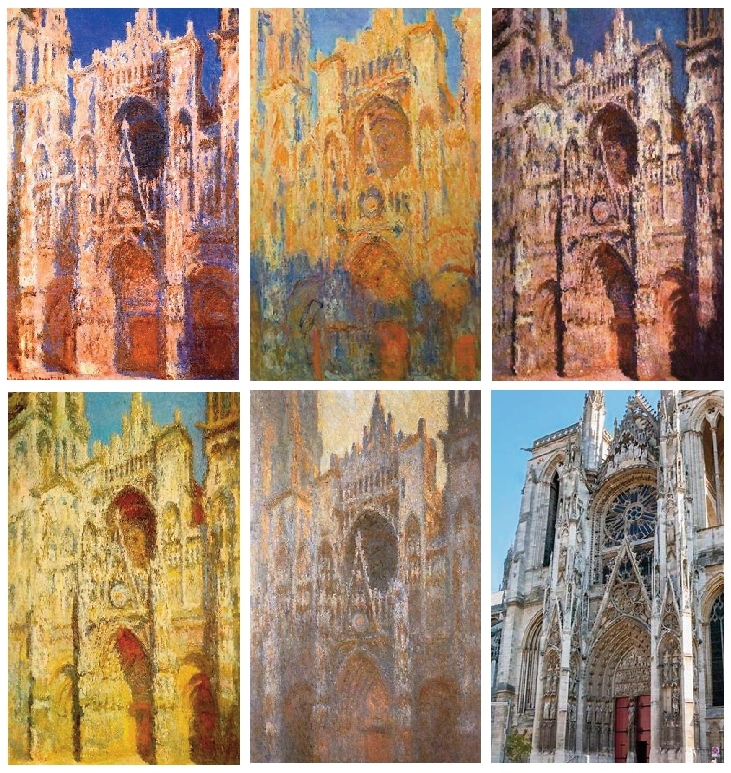Claude Monet
As a young adult entering into high school and collage you will notice that your language changes each year. As you mature you develop a stronger vocabulary in order to express yourself clearly. You discover other languages that expand your world view about other cultures. You hear languages that sound more interesting and more expressive than English. French is a language that sounds more beautiful than English because of the manner of how the language flows, as if every sentence were being sung.
Did you know that half of the english language is French? In english we put spaces or pauses between our words. We took French and added sharp edges to the language.
One of the greatest French artists was Claude Monet. His paintings flow visually as does the French language. Just as you mature with your language as the years pass so did his maturity of painting. The last decade of his life he focused on his maturity of managing the beauty of light by painting the way if fell on his gardens and pond. He created a world of nature from nature and presented his work to the world as paintings of meditation allowing you to get lost in the color and light. His visual language matured to this level. How will you mature with your language and manner that you will express yourself over the coming years? Perhaps studying the life of Monet will enable you to see in a unique manner as an example expressing yourself?
Claude Monet, 1840-1926 (aged 86) was a French painter, a founder of French Impressionist painting and the most consistent and prolific practitioner of the movement's philosophy of expressing one's perceptions before nature, especially as applied to plein air landscape painting.
Impressionism became popular because of its visual appeal of colors that blended into each other as though they were melting. There are virtually no hard edges in impressionistic work. The emphasis is on the tones of color that change though out the day. Light changes every 15 minutes and so follows color. The impressionists were plein air painters, meaning they painted outdoors for the most part. It was typical for an impressionist painter to begin a painting outdoors and then complete it in their studio.
Claude Monet lived to be the most famous of the Impressionist’s and the wealthiest.
Below is a photo of Monet in his studio working on one of his massive waterlily paintings. Click on the red information buttons to view a short video about his life and work and click on the camera buttons to view photographs related to him.
Claude Monet (French, 1840–1926) Village Street, about 1869–71 Oil on canvas
QUESTIONS to CONSIDER in FRENCH & ENGLISH: Can you answer the question in French?
This painting is largely made up of dark and light colors. Can you see how they balance each other so that one does not out weigh the other?
Cette peinture est en grande partie composée de couleurs sombres et claires. Pouvez-vous voir comment ils s'équilibrent les uns les autres afin que l'on ne pèse pas sur l'autre?
Look at the painting and then look away. See if you can remember what you saw then read on.
Regarde le tableau et regarde ailleurs. Voyez si vous pouvez vous souvenir de ce que vous avez vu puis lisez la suite.
Did you see the street signs on the bottom left? Did you see the trolly car tracks? Did you see the house boarded up from the winter? Did yo see a blue fence? Did you see people walking down hill?
Avez-vous vu les panneaux de rue en bas à gauche? Tu as vu les rails de la voiture de Trolly? Avez-vous vu la maison à bord de l'hiver? Avez-Yo vu une clôture bleue? Avez-vous vu des gens marcher sur la colline?
Harsh shadows are created only when the sun is directly above or almost directly above. What time of day then do you think it was?
Les ombres dures ne sont créées que lorsque le soleil est directement au-dessus ou presque directement au-dessus. À quel moment de la journée alors pensez-vous que c'était?
Claude Monet’s family moved from Paris to the northern port city of Le Havre when he was five. The Normandy beaches would provide the artist with so much inspiration during the first three decades of his career. Moreover, it was in Le Havre that young Monet first met Eugène Boudin, the artist who encouraged him to paint outdoors and to study the various effects of natural light. This approach to landscape painting would prove instrumental in Monet’s mature Impressionist style. In 1870, before the onset of the Franco-Prussian War, Monet and his new bride Camille Doncieux visited Trouville on the Normandy coast. Village Street was most likely painted on that trip, and it reveals Monet’s tendency to omit unessential detail in favor of a broad, generalizing impression. Painting clouds, trees, buildings, and a glimpse of the English Channel with just a few quick dashes of his brushes, Monet captured the effects of the late afternoon sun casting deep shadows across a broad avenue. Monet may have painted this canvas in one sitting, which demanded great powers of observation and sure brushwork. Those qualities gave expression to an arrested moment and lent Village Street its sense of authentic experience.
Below are 5 paintings of the Rouen Cathedral in France. He painted over 60 paintings of this one subject. It took him 2 years to do so. Notice how the light changes in each work and shadows appear. The effect of using color this way with oil paint takes a long time because each layer of oil must dry for days before another layer of color is added. Therefore there are many layers of oil paint that are built up on top of each other to give this effect. The bottom right photo is of the actual cathedral itself.
The Rouen Cathedral, France



